Ancient Egyptian Medicine Part II – Surgery
Charles Savona-Ventura MD DScMed FRCOG AccrCOG MRCPI
Professor of Obstetrics & Gynaecology
Faculty of Medicine & Surgery, University of Malta
The Ancient Egyptian surgeons were apparently well versed with the principles of surgical treatment of traumatic injuries and other disorders. Much of the details of surgical practice can be gleaned from the Edwin Smith Papyrus [transcribed text can be seen at http://www.reshafim.org.il/ad/egypt/timelines/topics/smithpapyrus.htm]. This papyrus dates to 1550 BC and was found in the tomb of a physician. It is now housed in the New York Academy of Sciences.
The text in this papyrus gives an insight on the Egyptian doctor’s approach to examining the patient, leading to a diagnosis and subsequent treatment. The treatise is systematically organized in an arrangement of cases, which begin with injuries of the head and proceed downward through the body, like a modern treatise on anatomy. The treatment of these injuries is rational and chiefly surgical; there is resort to magic in only one out of the forty-eight cases preserved. Each case is classified by one of three different verdicts: (1) favourable, (2) uncertain, or (3) unfavourable. The third verdict, expressed in the words, ‘an ailment not to be treated,’ is found in no other Egyptian medical treatise. The Edwin Smith Papyrus opens with eight texts concerning head wounds, followed by nineteen treatments of wounds to the face (forehead, eyebrows, nose, cheeks, temples, mouth and chin), six descriptions of how to deal with injuries to throat and neck, five dealing with collar-bones and arms, and seven with chest complaints.
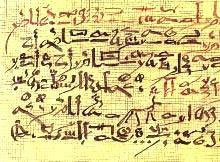
The papyrus suggests a highly sophisticated surgical practice which included the management of cranial injuries: If thou examinest a man having a gaping wound in his head, penetrating the bone, smashing his skull, (and) rending open the brain of his skull, thou shouldst palpate his wound. Shouldst thou find that smash which is in his skull like those corrugations which form in molten copper, (and) something therein throbbing (and) fluttering under the fingers like the weak place of an infant’s crown before it becomes whole-when it has happened there is no throbbing (and) fluttering under the fingers until the brain of his (the patient’s) skull is rent open-(and) he discharges blood from both his nostrils, (and) he suffers with stiffness in his neck. Thou shouldst say concerning him: “An ailment not to be treated.” Thou shouldst anoint that wound with grease. Thou shalt not bind it; thou shalt not apply two strips upon it: until thou knowest that he has reached a decisive point [Edwin Smith Papyrus: case 6].
Besides traumatic injuries, the surgeon also dealt with malignant tumours including breast cancer: If thou examinest a man having tumors on his breast, (and) thou findest that swelling have spread over his breast; if thou puttest thy hand upon his breast upon these tumors, (and) thou findest them very cool, there being no fever at all therein when thy hand touches him ; they have no granulation , they form no fluid, they do not generate secretions of fluid, and they are bulging to thy hand . Thou shouldst say concerning him: “One having tumors. An ailment with which I will contend.” There is no treatment. If thou findest tumors in any member of a man, thou shalt treat him according to these directions [Edwin Smith Papyrus: case 45]. Uterine cancer is mentioned in the Kahun and the Ebers texts: Thou shalt say as to it: “What is the smell that thou emittest (lit. causest to be perceived)?” If she says to thee: “I am emitting the smell of roast meat,” thou shalt say as to it, it is nemsu uteri. Thou shalt do for it (thus): fumigate her with every sort of roast meat, the smell of which she emits [Kahun Papyrus: case 2]. Another for one in whom there is eating on her uterus in whose vagina ulcers have appeared [Ebers Papyrus]. At least 39 mummies suffering from cancer have been identified.
The complication of tetanus or lockjaw was also identified and deemed untreatable: If then, thou findest that the flesh of that man has developed fever from wound which is in the sutures of his skull, while that man has developed ty’ from that wound, thou shouldst lay hand upon him. Shouldst find his countenance is clammy with sweat, the ligaments his neck are tense, his face ruddy, his teeth and his back, the odor of the chest of his head is like the bkn (urine) of sheep7, his mouth is bound, (and) both his eyebrows are drawn, while his face is as if he wept. Thou shouldst say regarding him: “One having a gaping wound in his head penetrating to the bone, perforating the sutures of his skull; he has developed ‘ty’, his mouth is bound, (and) he suffers with stiffness in his neck. An ailment not to be treated” [Edwin Smith papyrus: case 7]. The Ebers Papyrus also describes the treatment for abscesses: “Instructions for a swelling of pus …. A disease that I treat with knife-treatment. If anything remains in pocket, it recurs” [Ebers papyrus]. The Edwin Smith Papyrus recommends the suturing of non-infected wounds with a needle and thread. Raw meat was applied on the first day, subsequently replaced by a dressing of astringent herbs, honey and butter or bread.
Surgical procedures are also depicted in a number of tomb reliefs. The Tomb of Ankh-Mahor, known also as the Tomb of the Physician, at Saqqara, has a relief showing two men receiving some form of treatment – manicure, massage or surgery – to their extremities. The accompanying text implores the physician: Do not let it be painful, to which the physician responds: I do (it) so you will praise it, (O) king! 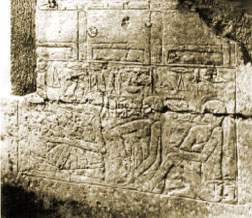
Similarly a relief depicted on the tomb of physician Sesi at Saqqara dated c.2400 BC depicts the performance of a circumcision on adolescents with the hieroglyphs saying: The ointment is used to make it acceptable. This has been interpreted as meaning that a local anaesthetic may have been used. Poppies (Spn) are occasionally mentioned in Egyptian medical literature, and the physicians must have had a pretty good idea of their properties. Female circumcision seems to have been practised occasionally: … I was circumcised, together with one hundred and twenty men, and one hundred and twenty women … [The Offering of Uha, c. 2400 BC]. 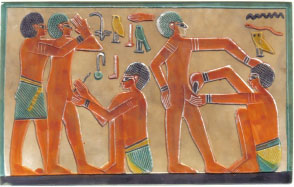
The care given to the injured in battle is depicted on a relief in the Great Temple of Abu Simbel. 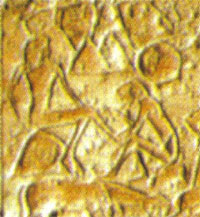
The Edwin Smith Papyrus lists lint, swabs, bandage, adhesive plaster (x-formed), postural support devices, surgical stitches and cauterization. The Cairo Museum has a collection of surgical instruments – including scalpels, scissors, copper needles, forceps, spoons, lancets, hooks, probes and pincers; some dating to the VI Dynasty discovered in the Tomb of Oar at Saqqara, described as the senior physician of the royal court. The use of surgical instruments is also clearly mentioned in the Ebers Papyrus: thou shalt perform an operation for it, the same being split with a knife and sized with a … (? forceps).
A collection of 37 instruments are engraved on the wall in the temple of Sobek at Kom-Ombo (dated 2nd century BC). These include bone saws, suction cups, knives and scalpels, retractors, scales, lances, chisels and dental tools. Trepanation, while not mentioned in any of the medical papyri, seems to have been performed occasionally using mallet and chisel, since 14 skulls, some of which were healed or partially healed, have been found. Limb amputations were also performed, the victims being assisted by the use of prosthesis. One mummy had three substitute teeth skilfully tied to the abutment teeth with fine gold wire instruments
.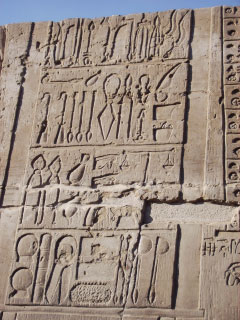
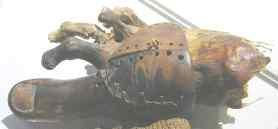 Toe prosthesis |
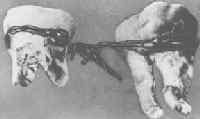 Dental prosthesis |

